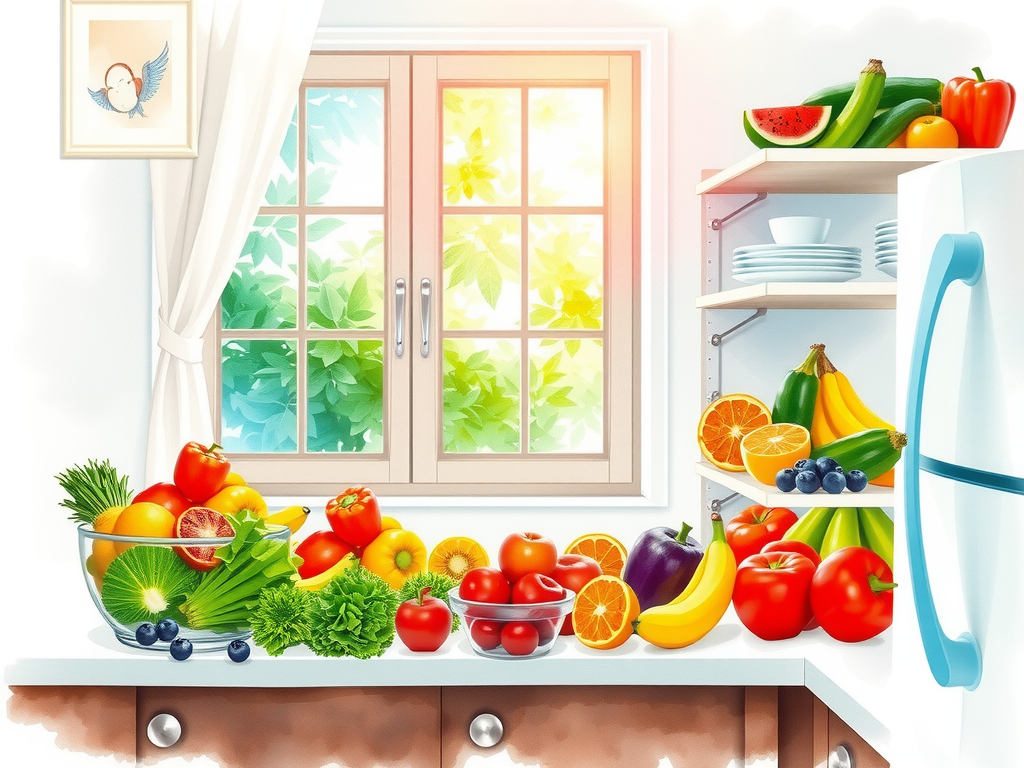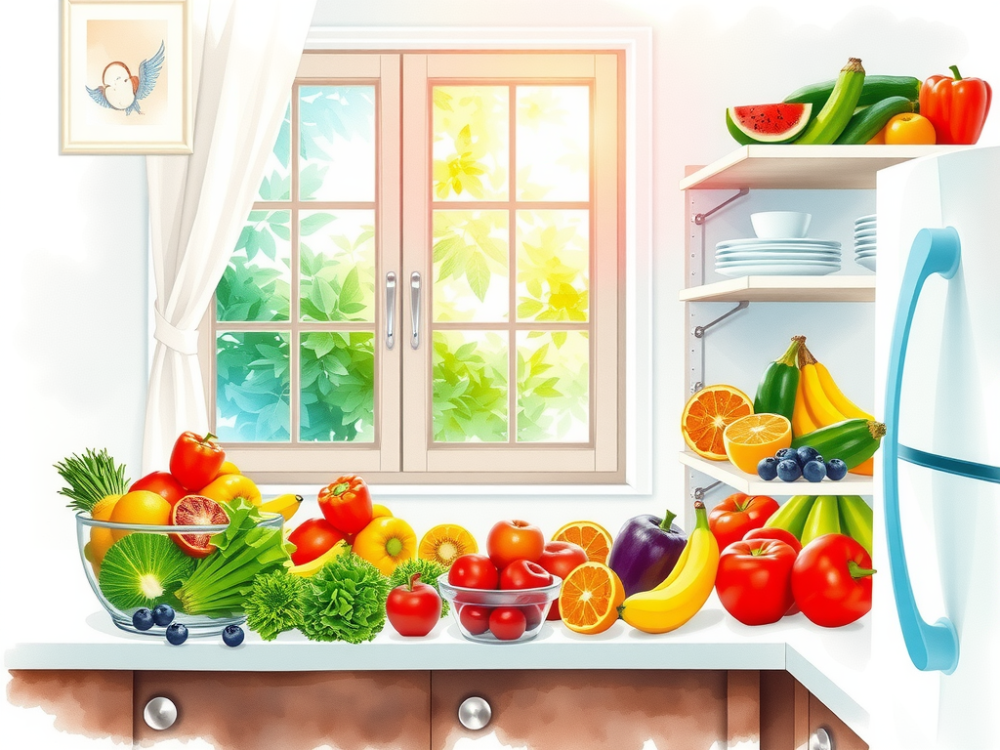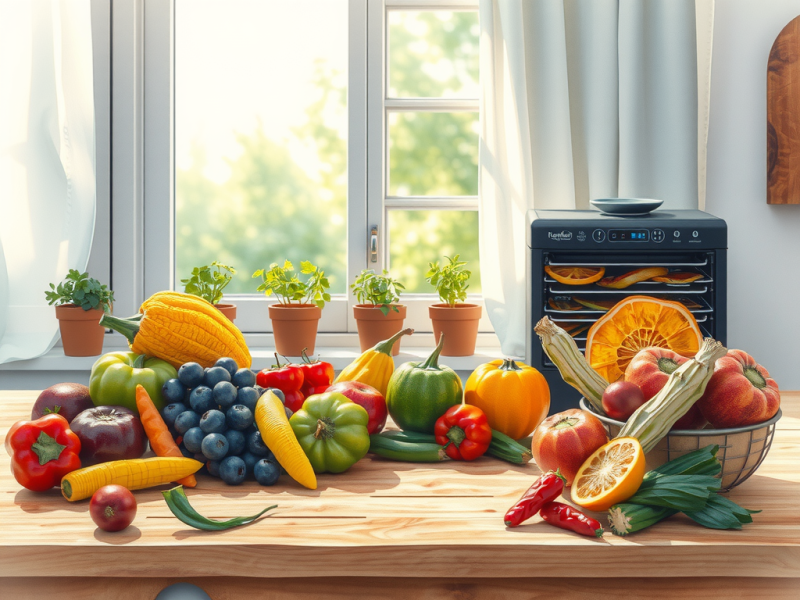
Food dehydration is an effective way to preserve food. This method keeps essential nutrients while creating healthy snacks that are delicious and convenient.
Dehydrators maintain fruits and vegetables intact, allowing you to enjoy their full health benefits.
Dehydrated foods offer a practical, cost-efficient storage solution and help reduce spoilage.
Here’s how to choose the best produce for dehydration and enhance your diet with natural options.
Click here to learn more about: freeze dryer vs dehydrator
Nutrient Preservation Benefits Of Dehydrators
The dehydration process retains nutrients in foods. It typically maintains up to 97% of nutrients, which is better than freezing or canning methods.
Flavor and texture are enhanced during dehydration, making the foods taste more concentrated and enjoyable. When selecting fruits and vegetables for dehydration, focus on nutrient-dense options like apples and kale.
High-quality produce ensures flavor and nutrient retention.
- Avoid overripe items to maximize nutrient preservation.
- Store dehydrated foods in airtight containers to maintain quality.
- Using dehydrators is an energy-efficient method for kitchen appliances.
By choosing the right ingredients, you support sustainable eating and enjoy a variety of wholesome snacks year-round.

How To Create Longlasting Food At Home
Creating longlasting food at home is simple and effective. First, choose fresh, ripe foods such as fruits, vegetables, or meats.
Freshness is key for nutrient preservation.
Next, wash and cut your food into uniform pieces.
This ensures even drying. Additionally, blanch vegetables briefly to maintain color and nutrients.
Use a food dehydrator according to the manufacturer’s instructions for temperature and time. Proper drying is necessary for food longevity and safety.
Finally, store your dehydrated items in airtight storage containers in a cool, dark place.
Avoid common mistakes such as overcrowding the dehydrator and neglecting to check for dryness before storing.
Essential Steps in Dehydration
- Choose fresh ingredients for optimal nutrient retention.
- Wash fruits and vegetables thoroughly.
- Cut food into even pieces for uniform drying.
- Blanch vegetables to preserve their color.
- Follow dehydration instructions closely to ensure safety.
Storage Methods to Maintain Freshness
- Use airtight containers to prevent moisture from entering.
- Store dehydrated foods in a dark area to avoid light exposure.
- Label containers to track freshness easily.
Common Mistakes to Avoid
Avoid overcrowding the dehydrator. This can lead to uneven drying.
Check for proper dryness before putting food away.
EnergySaving Storage Solutions For Snacks
Efficient storage solutions for snacks help reduce waste. First, using dehydrators eliminates the need for refrigeration, which saves energy. Dried fruits and vegetables become lightweight snacks ideal for travel. Next, opt for glass jars or Mylar bags for storage. Both options offer protection against light and moisture. Also, labeling containers helps keep track of contents and freshness. Organizing snacks by type minimizes the need to open multiple containers, conserving energy. Adopt these strategies for efficient storage and enjoy flavorful, healthy snacks with reduced spoilage.
Benefits of Using Dehydrators
- Nutrient retention: Maintains up to 97% of nutrients, outperforming freezing.
- Long shelf life: Properly stored dehydrated foods last for months.
- Cost-effective: Reduces food waste and cuts down the need for store snacks.
Alternative Storage Solutions
Consider using:
- Glass jars for easy visibility and access.
- Mylar bags for extra protection against moisture.
- Airtight containers to keep snacks fresh longer.
Strategies for Organizing Snacks
To reduce energy use:
- Organize snacks by type for easy access.
- Keep frequently used items at eye level.
- Limit openings of storage containers to maintain freshness.
| Key Process | Benefits |
|---|---|
| Dehydration | Maintains up to 97% of nutrients |
| Airtight Storage | Prevents moisture and light exposure |
| Organizing Snacks | Minimizes energy use by reducing container openings |
| Using Glass Jars | Provides easy visibility and access |
Lightweight Snacks For On-the-Go Convenience
Travelers often seek nutritious options that are easy to carry. Dehydrated snacks are ideal for travel and outdoor activities.
These snacks are lightweight, easy to pack, and packed with flavor.
You can create tasty combinations like a dried fruit and nut mix or cheese sticks paired with homemade jerky.
For bulk preparation, consider making a large batch of vegetable chips or fruit leathers. Store these in airtight containers to keep them fresh.
Preparing snacks in advance streamlines your options for healthy alternatives while minimizing waste and spoilage during your adventures.
Did you know? Dehydration maintains up to 97% of nutrients in foods, making dehydrated snacks a nutrient-dense option.
Portable Snack Combinations
Create flavor-packed snacks by mixing dried fruits, nuts, and seeds. Dried vegetables also work well in trail mixes.
You can try a combination of gourmet jerky and homemade chips for added protein.
Use seasonal ingredients for sustainable eating that supports local agriculture.
Preparing Portable Meals With A Dehydrator
Planning meals for dehydration ensures nutritional integrity while keeping food prep simple.
Focus on balancing proteins, carbs, and healthy fats. For example, prepare a vegetable soup mix using dried herbs and vegetables or a quinoa and bean salad.
Easy rehydration methods include soaking the dried meals in warm water or adding them directly to soups. This method ensures cost-efficient snacks that reduce spoilage.
Quick Tip: Use a food dehydrator to make healthy snacks at home.
It helps to preserve flavor and nutrients while being energy-efficient.
Recipe Ideas
Consider recipes like homemade jerky and dried fruit leather.
Both are easy to prepare and highly portable.
Dehydrated vegetables can enhance flavor in meals, making them versatile for different recipes.
Rehydration Techniques
Proper rehydration makes your meals flavorful. Soak dried foods in warm water for 10-15 minutes or add them directly to simmering dishes.
This keeps your meals nutritious and quick to prepare, allowing for enjoyable camping food or on-the-go options.
Lightweight Snacks
- Dehydrated snacks maintain up to 97% of their nutrients, making them a highly nutritious choice.
- Portable snacks like dried fruits, nuts, and seeds are ideal for on-the-go convenience.
- Using a food dehydrator is an energy-efficient way to make healthy snacks at home.
- Proper rehydration techniques ensure meals remain flavorful and nutritious, perfect for camping or travel.
Natural Foods: Why Choose Dehydrated Options
Selecting dehydrated foods offers numerous health benefits that cannot be overlooked. These options retain up to 97% of nutrients, outperforming many processed alternatives.
Additionally, dehydration improves food safety by reducing moisture, which minimizes bacterial growth.
The environmental impact is also significant.
Choosing dehydration helps reduce food waste, promoting a sustainable lifestyle.
Integrating dehydrated vegetables and fruits into daily meals is easy. You can enjoy them as snacks, or add them to soups and stews for extra flavor and nutrition.
This method encourages nutrient preservation and supports eco-friendly practices.
Benefits of Dehydrated Foods
Nutrient retention in dehydrated foods is impressive. They maintain essential vitamins and minerals, unlike some other preservation methods.
Properly stored dehydrated foods can last for months or even years, ensuring long-lasting food options for your pantry.
Dehydration is also energy-efficient.
It requires no refrigeration, significantly reducing energy use.
Dehydrated foods are portable and lightweight, making them perfect for travel and outdoor activities. This convenience aligns perfectly with health-conscious choices.
What Are Healthy Alternatives To Processed Snacks
Finding healthy alternatives to processed snacks is simple with dehydrated options.
Dried fruits and veggie chips are popular choices that are free from harmful additives and provide essential nutrients. Using natural ingredients to create homemade chips or jerky allows for quality control.
Incorporating whole foods into your diet enhances health outcomes.
For example, dried fruits can serve as nutritious snacks, while vegetable dehydration offers crunchy options over fried chips.
Creating DIY snacks not only promotes culinary creativity but also supports improved health.
Making Healthy Snacks at Home
Making homemade jerky or fruit leather is an easy way to ensure nutritious snacks.
These options are cost-effective and allow for personal taste preferences. You can control added sugars and sodium, maintaining the nutritional integrity of your snacks.
Additionally, dehydrated vegetables can be rehydrated and used in soups and casseroles, giving you versatile ingredients for healthy meals.
This approach extends the seasonality of your favorite produce and prevents spoilage.
Dehydrated Foods
- Dehydrated foods retain up to 97% of their nutrients, making them a healthier choice than many processed options.
- Properly stored dehydrated foods can last for months or even years, providing long-term food solutions.
- Dehydration requires no refrigeration, which significantly reduces energy consumption.
- Dried fruits and veggie chips are free from harmful additives, offering nutritious snack alternatives.
Ensuring Food Safety With Dehydration Techniques
Food safety is important during dehydration. Dehydration removes moisture, which prevents microbial growth and spoilage.
High temperatures help to eliminate pathogens.
A safe drying temperature is 140°F (60°C for meats.
Pre-treatment methods, such as blanching vegetables, also help eliminate bacteria.
Critical Safety Measures
Follow these safety measures for proper dehydration:
- Use a food dehydrator or oven set to the right temperature.
- Clean fruits and vegetables thoroughly before drying.
- Store items in airtight containers to reduce spoilage.
Importance of Proper Storage
Maintaining food longevity relies on correct storage. Store dehydrated foods in a cool, dark place to retain flavor and freshness. Label containers with dates for tracking. Proper storage extends the shelf life significantly, making it easier to enjoy healthy snacks year-round.
Resources for Troubleshooting
If issues arise during dehydration, refer to reliable resources for troubleshooting. The National Center for Home Food Preservation provides guidance on best practices. Understanding common problems enhances food safety.
| Safety Measure | Recommended Practice |
|---|---|
| Drying Temperature | 140°F (60°C for meats) |
| Pre-treatment Method | Blanching vegetables |
| Storage Condition | Cool, dark place in airtight containers |
| Resource for Guidance | National Center for Home Food Preservation |



